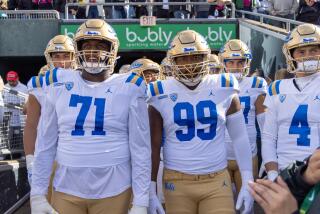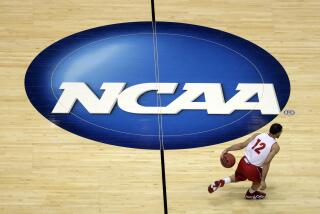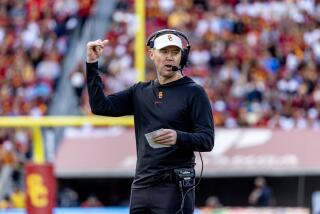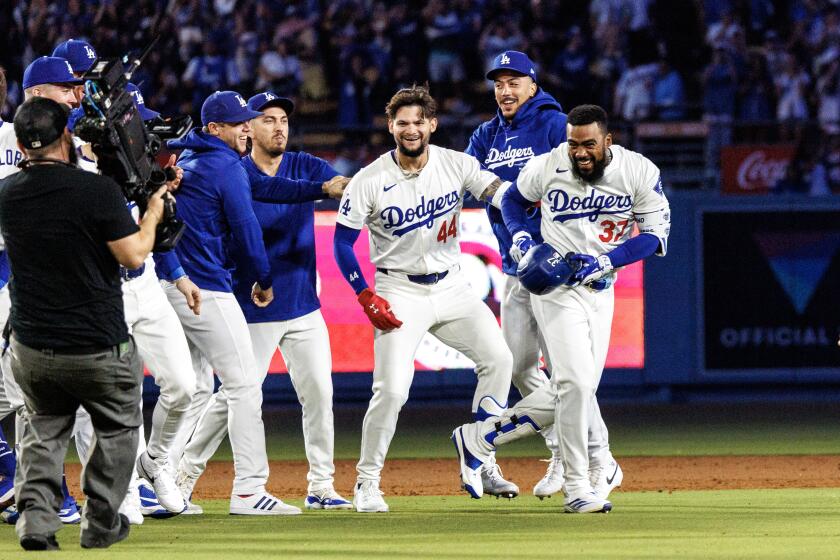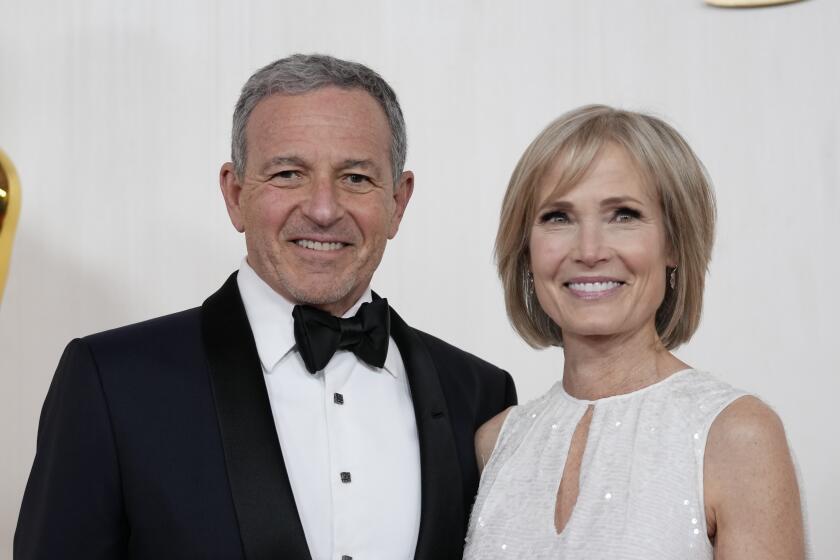Looking at the practice of awarding huge buyouts to major college football coaches
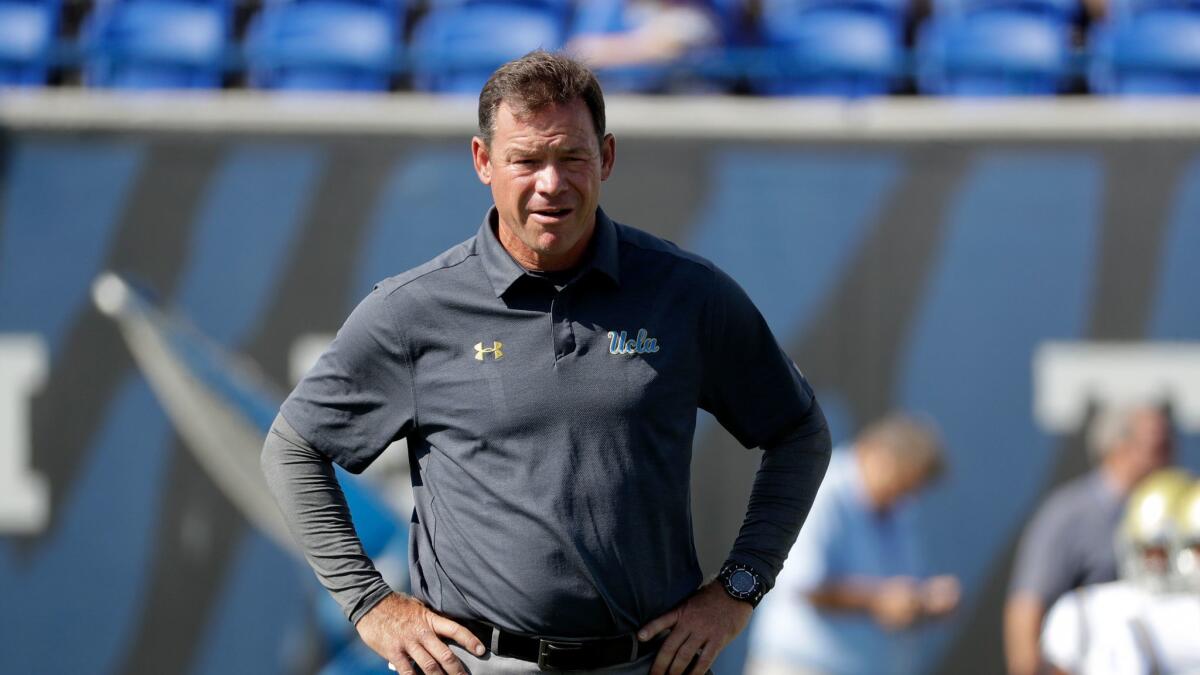
The rising price of big-time college football is reflected in dry language buried within the 2 ½ -page contract extension Jim Mora signed with UCLA last year.
Sixty-one words detail the bill for UCLA to fire the coach without cause: “Eighty percent of the Base Salary and Talent Fee remaining to be paid ...”
That meant the school could owe Mora more than $12 million after dismissing him last month. That’s almost as much as UCLA’s $13.6-million tab for athletic scholarships in the 2015-16 fiscal year, according to the U.S. Department of Education’s Equity in Athletics report.
The press release announcing Mora’s firing didn’t note the lucrative going-away gift.
“It’s insane by any standard,” said Ramogi Huma, a former UCLA football player who is president of the reform-minded College Athletes Players Assn. “Just when you think you’ve got your head wrapped about the numbers, something like this happens. It reminds you that by no means is this amateur athletics.”
But Mora’s eight-figure payout isn’t unusual. In recent weeks, Arizona State paid Todd Graham $12.1 million to leave, Arkansas gave Bret Bielema $11.8 million and former Texas A&M coach Kevin Sumlin got $10.4 million.
The reported buyouts for some coaches who remain employed are even bigger. They include Utah’s Kyle Whittingham ($12.3 million), Iowa’s Kirk Ferentz ($22.5 million), Alabama’s Nick Saban ($26.9 million) and, what is believed to be the largest figure in college football, Clemson’s Dabo Swinney ($40 million).

“Over time there has been compensation creep, which nowadays is almost compensation leaps,” said Raymond D. Cotton, a Washington-based lawyer and executive compensation expert who has represented more than 350 higher-education and nonprofit institutions. “These levels of income, in my opinion, are way beyond what’s reasonable.”
Mora’s buyout — which Chancellor Gene Block had a say in exercising — provides a window into an often-overlooked part of college football’s financial arms race. The buyout works out to about $260,000 for each of the 46 games Mora won in six seasons at UCLA.
“It’s really interesting,” UCLA athletic director Dan Guerrero said last month when asked about the buyout’s size. “When you talk about where UCLA athletics was in 2002 when I first got here and where we are now, certainly that wouldn’t have been an option back in the day. But we’ve really built our support base, our financial resource base over the years.”
Guerrero expects to bring in additional revenue from a spike in season-ticket sales after hiring Chip Kelly to replace Mora.
Or, as Michigan sports economist and professor of sports management Rodney Fort put it, “This signals an incredibly healthy state for college football.”
Mora’s contract contains offset language, meaning the buyout would be reduced if he accepts another coaching job. UCLA has the option to reduce the amount due to Mora if it determines he declined a “reasonable offer of employment” or showed a “lack of diligence in seeking employment.” The buyout will be paid over the life of the contract, which ran through 2021, rather than in a lump sum.
A UCLA spokeswoman said of the amount: “There are some variables.”
Had Mora left UCLA on his own for another job this year, he would have owed the school $1.7 million.
“The contracts are doing exactly what the coaches intended them to do,” Fort said.
The school will finance the buyout using funds generated by the athletic department from ticket sales, sponsorships, donations and broadcast rights fees. That revenue includes the record 15-year, $280-million apparel deal with Under Armour. The contract called for the company to pay the school a $15-million signing bonus over the summer in addition to a $9-million annual rights fee.

That deal fits the pattern of big money flowing through the Football Bowl Subdivision. The median total revenue for each school in the sport’s top level of college competition was $63.7 million in 2015-16. UCLA’s athletic department pulled in $98.9 million during the same time against similar expenses.
The school expects expenses to surpass $100 million in the current fiscal year.
“Personally, and I emphasize personally,” said David Teplow, a UCLA neurology professor and president of the school’s chapter of the American Assn. of University Professors, “it is my feeling that there is something quite bizarre about athletic coaches being paid millions of dollars in salary each year while those whose jobs are to educate young men and women, and in my case, to make breakthroughs in medicine and science, must struggle to run our laboratories and to pay our salaries.”
The chair of UCLA’s faculty-run Academic Senate and the chair of the Senate’s Intercollegiate Athletics Committee both declined comment on the buyout.
Huma would like to see the buyout money instead directed to help injured athletes after their college careers end or improving academic options for current athletes.
B. David Ridpath, a former college athletic department administrator and professor of sports administration at Ohio University, doesn’t see the need for the sizable expenditures to attract coaches at public schools.
“When higher education is struggling for money and most college athletic programs are hemorrhaging money, it is insane to keep this up,” Ridpath said. “Any of the perceived benefits of college sports would happen regardless of this. … We can spend millions less for the same outcomes, yet we spend more thinking something magical will happen when 99% of the time it doesn’t work out or change a thing.”
But one big-money buyout didn’t stop UCLA from agreeing to a similar clause in Kelly’s five-year, $23.3-million contract.
If the much-hyped match doesn’t work out, the school owes the coach $9 million.
::
Top 10 highest college coach buyout clauses (as of Dec. 1):
Dabo Swinney, Clemson, $40,000,000
Chris Petersen, Washington, $30,671,875
Nick Saban, Alabama, $26,900,000
Kirk Ferentz, Iowa, $22,537,500
James Franklin, Penn State, $21,858,333
Urban Meyer, Ohio State, $21,345,1000
Jim Harbaugh, Michigan, $20,555,556
Tom Herman, Texas, $20,416,667
Bronco Mendenhall, Virginia, $17,425,000
Lovie Smith, Illinois, $16,500,000
Source: media reports.
Note: Texas A&M this week hired Jimbo Fisher to a 10-year, $75-million guaranteed contract; his buyout at former employer Florida State was $39,312,500.
Twitter: @nathanfenno
More to Read
Get our high school sports newsletter
Prep Rally is devoted to the SoCal high school sports experience, bringing you scores, stories and a behind-the-scenes look at what makes prep sports so popular.
You may occasionally receive promotional content from the Los Angeles Times.
